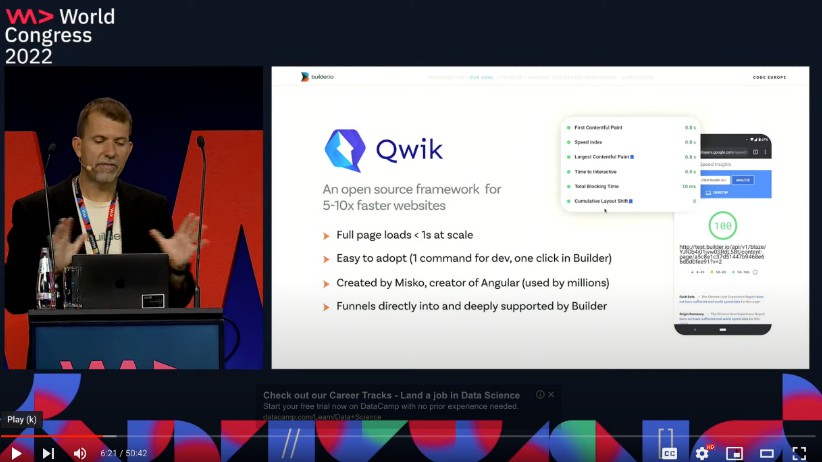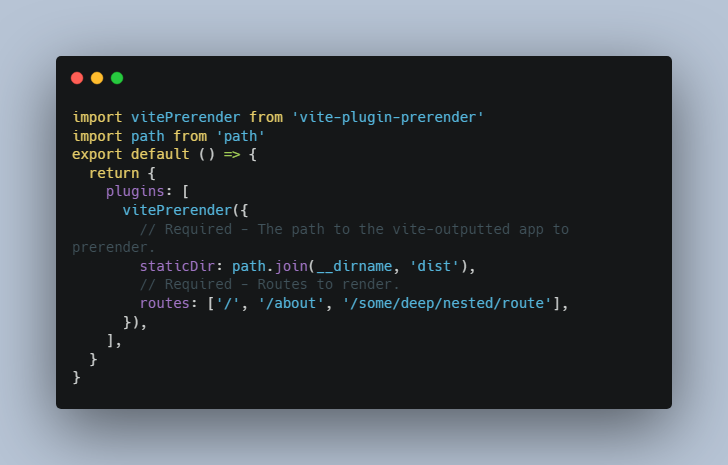After.js
If Next.js and React Router had a baby...
Project Goals / Philosophy / Requirements
Next.js is awesome. However, its routing system isn't for me. IMHO React Router 4 is a better foundation upon which such a framework should be built....and that's the goal here:
- Routes are just components and don't / should not have anything to do with folder structure. Static route configs are fine.
- Next.js's
getInitialPropswas/is a brilliant idea. - Route-based code-splitting should come for free or be easy to opt into.
- Route-based transitions / analytics / data loading / preloading etc. , should either come for free or be trivial to implement on your own.
Getting Started with After.js
After.js enables Next.js-like data fetching with any React SSR app that uses React Router 4.
Razzle Quickstart
You can quickly bootstrap an SSR React app with After.js using Razzle. While Razzle is not required, this documentation assumes you have the tooling setup for an isomorphic React application.
yarn global add create-razzle-app
create-razzle-app --example with-afterjs myapp
cd myapp
yarn start
Refer to Razzle's docs for tooling, babel, and webpack customization.
Data Fetching
For page components, you can add a static async getInitialProps function.
This will be called on both initial server render, and then client mounts.
Results are made available on this.props.
// ./src/About.js
import React from 'react';
import { NavLink } from 'react-router-dom';
class About extends React.Component {
static async getInitialProps({ req, res, match }) {
const stuff = await CallMyApi();
return { stuff };
}
render() {
return (
<div>
<NavLink to="/">Home</NavLink>
<NavLink to="/about">About</NavLink>
<h1>About</h1>
{this.props.stuff ? this.props.stuff : 'Loading...'}
</div>
);
}
}
export default About;
getInitialProps: (ctx) => Data
Within getInitialProps, you have access to all you need to fetch data on both
the client and the server:
req?: Request: (server-only) A Express.js request objectres?: Request: (server-only) An Express.js response objectmatch: React Router 4'smatchobject.history: React Router 4'shistoryobject.location: (client-only) React Router 4'slocationobject.
Injected Page Props
- Whatever you have returned in
getInitialProps prefetch: (pathname: string) => void- Imperatively prefetch and cache data for a path. Under the hood this will map through your route tree, call the matching route'sgetInitialProps, store it, and then provide it to your page component. If the user ultimately navigates to that path, the data and component will be ready ahead of time. In the future, there may be more options to control cache behavior in the form of a function or time in milliseconds to keep that data around.refetch: (nextCtx?: any) => void- Imperatively callgetInitialPropsagain
Routing
As you have probably figured out, React Router 4 powers all of After.js's
routing. You can use any and all parts of RR4.
Parameterized Routing
// ./src/routes.js
import Home from './Home';
import About from './About';
import Detail from './Detail';
// Internally these will become:
// <Route path={path} exact={exact} render={props => <component {...props} data={data} />} />
const routes = [
{
path: '/',
exact: true,
component: Home,
},
{
path: '/about',
component: About,
},
{
path: '/detail/:id',
component: Detail,
},
];
export default routes;
// ./src/Detail.js
import React from 'react';
import NavLink from 'react-router-dom/NavLink';
class Detail extends React.Component {
// Notice that this will be called for
// /detail/:id
// /detail/:id/more
// /detail/:id/other
static async getInitialProps({ req, res, match }) {
const item = await CallMyApi(`/v1/item${match.params.id}`);
return { item };
}
render() {
return (
<div>
<h1>Detail</h1>
{this.props.item ? this.props.item : 'Loading...'}
<Route
path="/detail/:id/more"
exact
render={() => <div>{this.props.item.more}</div>}
/>
<Route
path="/detail/:id/other"
exact
render={() => <div>{this.props.item.other}</div>}
/>
</div>
);
}
}
export default Detail;
Client Only Data and Routing
In some parts of your application, you may not need server data fetching at all
(e.g. settings). With After.js, you just use React Router 4 as you normally
would in client land: You can fetch data (in componentDidMount) and do routing
the same exact way.
Code Splitting
After.js lets you easily define lazy-loaded or code-split routes in your _routes.js file. To do this, you'll need to modify the relevant route's component definition like so:
// ./src/_routes.js
import React from 'react';
import Home from './Home';
import { asyncComponent } from '@jaredpalmer/after';
export default [
// normal route
{
path: '/',
exact: true,
component: Home,
},
// codesplit route
{
path: '/about',
exact: true,
component: asyncComponent({
loader: () => import('./About'), // required
Placeholder: () => <div>...LOADING...</div>, // this is optional, just returns null by default
}),
},
];
Custom <Document>
After.js works similarly to Next.js with respect to overriding HTML document structure. This comes in handy if you are using a CSS-in-JS library or just want to collect data out of react context before or after render. To do this, create a file in ./src/Document.js like so:
// ./src/Document.js
import React from 'react';
import { AfterRoot, AfterData } from '@jaredpalmer/after';
class Document extends React.Component {
static getInitialProps({ assets, data, renderPage }) {
const page = renderPage();
return { assets, data, ...page };
}
render() {
const { helmet, assets, data } = this.props;
// get attributes from React Helmet
const htmlAttrs = helmet.htmlAttributes.toComponent();
const bodyAttrs = helmet.bodyAttributes.toComponent();
return (
<html {...htmlAttrs}>
<head>
<meta httpEquiv="X-UA-Compatible" content="IE=edge" />
<meta charSet="utf-8" />
<title>Welcome to the Afterparty</title>
<meta name="viewport" content="width=device-width, initial-scale=1" />
{helmet.title.toComponent()}
{helmet.meta.toComponent()}
{helmet.link.toComponent()}
{assets.client.css && (
<link rel="stylesheet" href={assets.client.css} />
)}
</head>
<body {...bodyAttrs}>
<AfterRoot />
<AfterData data={data}/>
<script
type="text/javascript"
src={assets.client.js}
defer
crossOrigin="anonymous"
/>
</body>
</html>
);
}
}
export default Document;
If you were using something like styled-components, and you need to wrap you entire app with some sort of additional provider or function, you can do this with renderPage().
// ./src/Document.js
import React from 'react';
import { ServerStyleSheet } from 'styled-components'
import { AfterRoot, AfterData } from '@jaredpalmer/after';
export default class Document extends React.Component {
static getInitialProps({ assets, data, renderPage }) {
const sheet = new ServerStyleSheet()
const page = renderPage(App => props => sheet.collectStyles(<App {...props} />))
const styleTags = sheet.getStyleElement()
return { assets, data, ...page, styleTags};
}
render() {
const { helmet, assets, data, styleTags } = this.props;
// get attributes from React Helmet
const htmlAttrs = helmet.htmlAttributes.toComponent();
const bodyAttrs = helmet.bodyAttributes.toComponent();
return (
<html {...htmlAttrs}>
<head>
<meta httpEquiv="X-UA-Compatible" content="IE=edge" />
<meta charSet="utf-8" />
<title>Welcome to the Afterparty</title>
<meta name="viewport" content="width=device-width, initial-scale=1" />
{helmet.title.toComponent()}
{helmet.meta.toComponent()}
{helmet.link.toComponent()}
{/** here is where we put our Styled Components styleTags... */}
{styleTags}
</head>
<body {...bodyAttrs}>
<AfterRoot />
<AfterData data={data}/>
<script
type="text/javascript"
src={assets.client.js}
defer
crossOrigin="anonymous"
/>
</body>
</html>
);
}
To use your custom <Document>, pass it to the Document option of your After.js render function.
// ./src/server.js
import express from 'express';
import { render } from '@jaredpalmer/after';
import routes from './routes';
import MyDocument from './Document';
const assets = require(process.env.RAZZLE_ASSETS_MANIFEST);
const server = express();
server
.disable('x-powered-by')
.use(express.static(process.env.RAZZLE_PUBLIC_DIR))
.get('/*', async (req, res) => {
try {
// Pass document in here.
const html = await render({
req,
res,
document: MyDocument
routes,
assets,
});
res.send(html);
} catch (error) {
console.log(error);
res.json(error);
}
});
export default server;
Custom/Async Rendering
You can provide a custom (potentially async) rendering function as an option to After.js render function.
If present, it will be used instead of the default ReactDOMServer renderToString function.
It has to return an object of shape { html : string!, ...otherProps }, in which html will be used as the rendered string
Thus, setting customRenderer = (node) => ({ html: ReactDOMServer.renderToString(node) }) is the the same as default option.
otherProps will be passed as props to the rendered Document
Example :
// ./src/server.js
import React from 'react';
import express from 'express';
import { render } from '@jaredpalmer/after';
import { renderToString } from 'react-dom/server';
import { ApolloProvider, getDataFromTree } from 'react-apollo';
import routes from './routes';
import createApolloClient from './createApolloClient';
import Document from './Document';
const assets = require(process.env.RAZZLE_ASSETS_MANIFEST);
const server = express();
server
.disable('x-powered-by')
.use(express.static(process.env.RAZZLE_PUBLIC_DIR))
.get('/*', async (req, res) => {
const client = createApolloClient({ ssrMode: true });
const customRenderer = node => {
const App = <ApolloProvider client={client}>{node}</ApolloProvider>;
return getDataFromTree(App).then(() => {
const initialApolloState = client.extract();
const html = renderToString(App);
return { html, initialApolloState };
});
};
try {
const html = await render({
req,
res,
routes,
assets,
customRenderer,
document: Document,
});
res.send(html);
} catch (error) {
res.json(error);
}
});
export default server;





